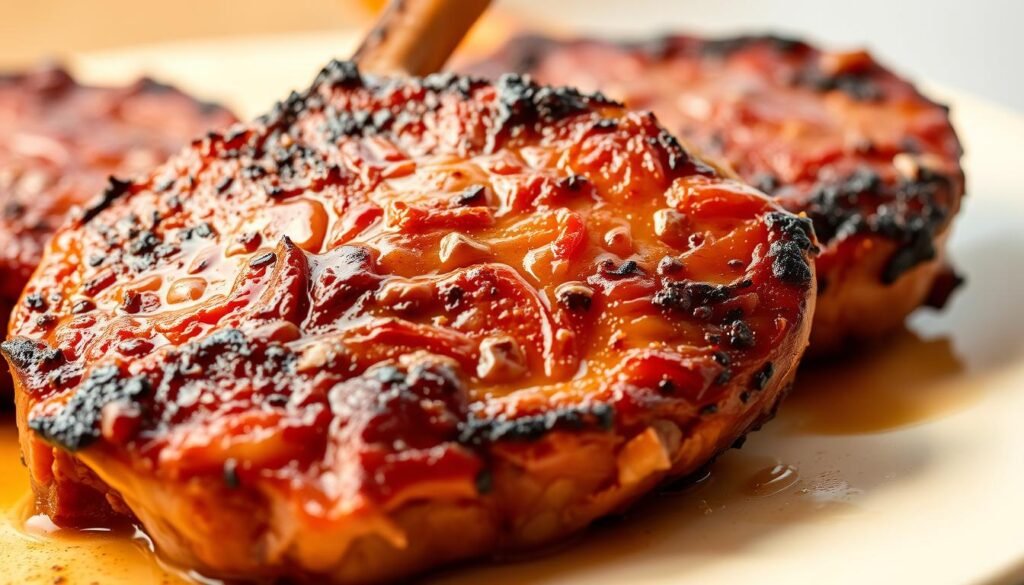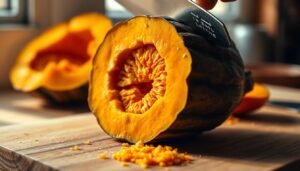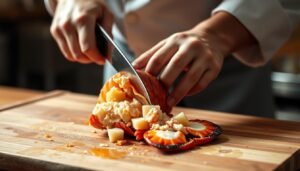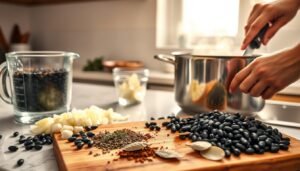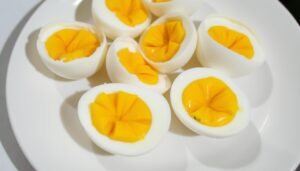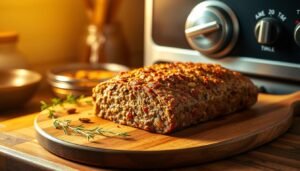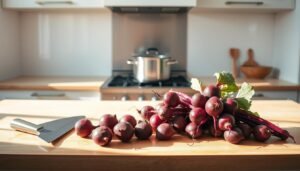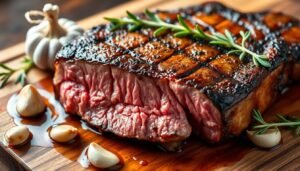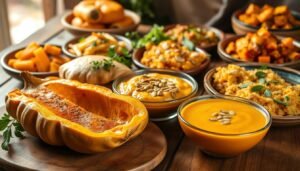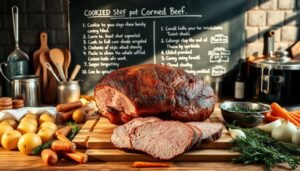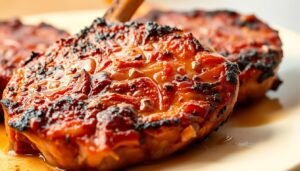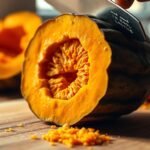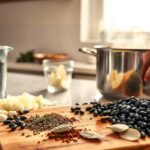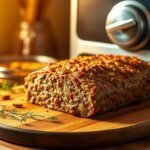Did you know nearly 70% of Americans love cooking pork at home? It’s a favorite meat in many kitchens. Making oven-baked pork chops is easy and rewarding. You’ll learn how to make tender, juicy pork chops with just a few ingredients.
This method is great for busy weeknights, whether you choose boneless or bone-in cuts. Let’s start cooking and find out how to cook pork chops in the oven perfectly!
Key Takeaways
- Oven-baked pork chops are a popular dish among Americans.
- Creating juicy pork chops requires simple ingredients.
- The recipe is perfect for quick weeknight dinners.
- Both boneless and bone-in cuts produce excellent results.
- Understanding cooking times is essential for perfect pork chops.
Understanding Pork Chops: Types and Cuts
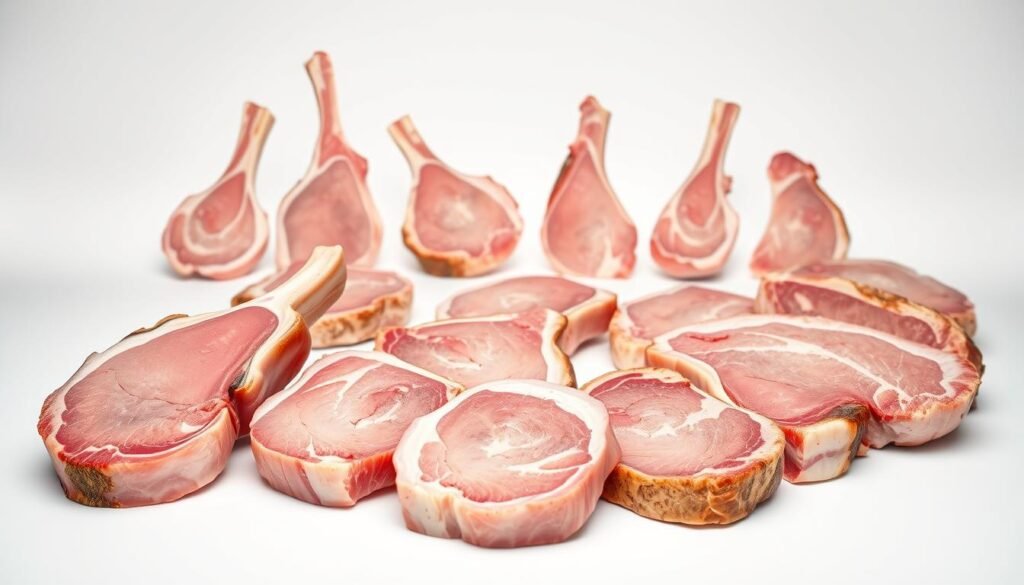
Choosing the right pork chop is key to a great dish. Each cut has its own taste and texture. This choice is crucial for the best results in my cooking.
I love the tenderness of boneless chops and the richness of bone-in ones. The variety in cuts of pork makes cooking more exciting.
Different Cuts of Pork Chops
There are many types of pork chops, each with its own traits. Here’s a quick look at some popular ones:
| Cut | Description | Flavor Profile | Texture |
|---|---|---|---|
| Boneless Loin Chop | Lean cut from the back of the pig | Mild | Tender |
| Bone-In Loin Chop | Includes a portion of the rib bone | Rich and flavorful | Juicier due to the bone |
| Rib Chop | Cut from the rib section | Buttery | Meaty and tender |
| Shoulder Chop | Cut from the shoulder area | Rich, porky flavor | More fibrous, ideal for slow cooking |
Flavor Profiles and Textures
Knowing the flavor profiles of pork is important. Bone-in chops stay moist and taste better. Boneless loin chops are easy to cook and quick to make.
When I try different pork chops, I notice how their textures change my dishes.
Preparing Your Pork Chops for Cooking
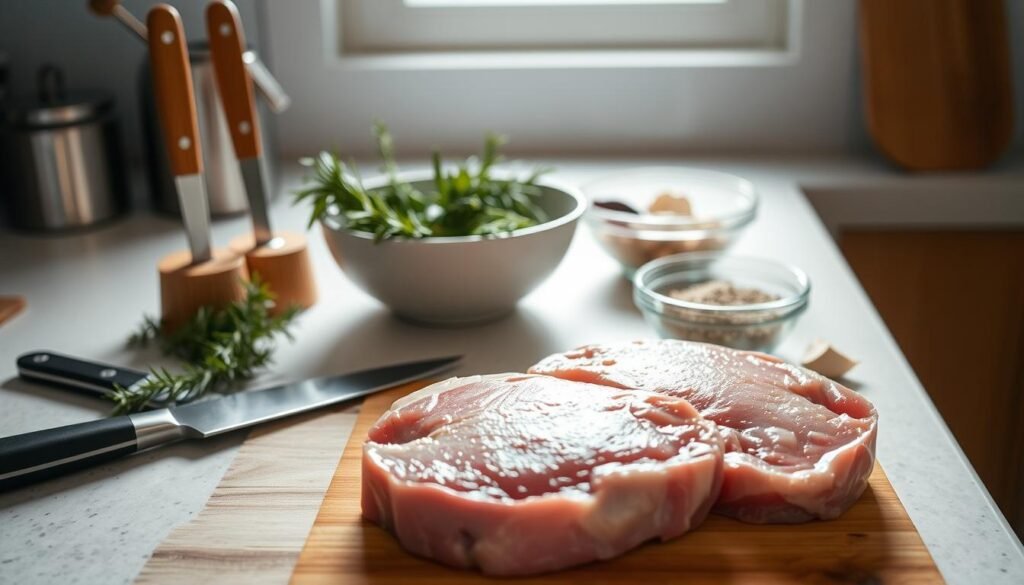
Choosing the right way to prepare pork chops is crucial for taste and texture. Marinating and dry seasoning have different roles. They help me make meals that everyone will enjoy.
Marinating vs. Dry Seasoning
Marinating pork adds flavor and makes it tender. It uses acidic ingredients like vinegar or citrus, mixed with herbs and spices. This method breaks down tough proteins, making the meat juicy and flavorful.
Dry seasoning, on the other hand, highlights the pork’s natural taste. A simple mix of salt, pepper, and spices brings out the meat’s flavor without overwhelming it. It’s great for quick meals when you’re short on time.
Essential Tools You’ll Need
Having the right tools makes cooking pork chops easier and more fun. Here’s a list of must-haves for preparing pork chops:
| Tool | Purpose |
|---|---|
| Instant-read thermometer | Ensures pork reaches safe cooking temperatures. |
| Baking dish | Holds the pork chops during cooking, minimizing mess. |
| Mixing bowl | Use for mixing marinades or spices. |
| Meat tenderizer | Breaks down tough fibers for fork-tender results. |
| Whisk | Perfect for blending marinades thoroughly. |
With these tools, I’m all set for any pork chop recipe. Whether I choose to marinate or dry season, the key is in the preparation.You can learn more about how to cook rice.
How Long to Cook Pork Chops in the Oven
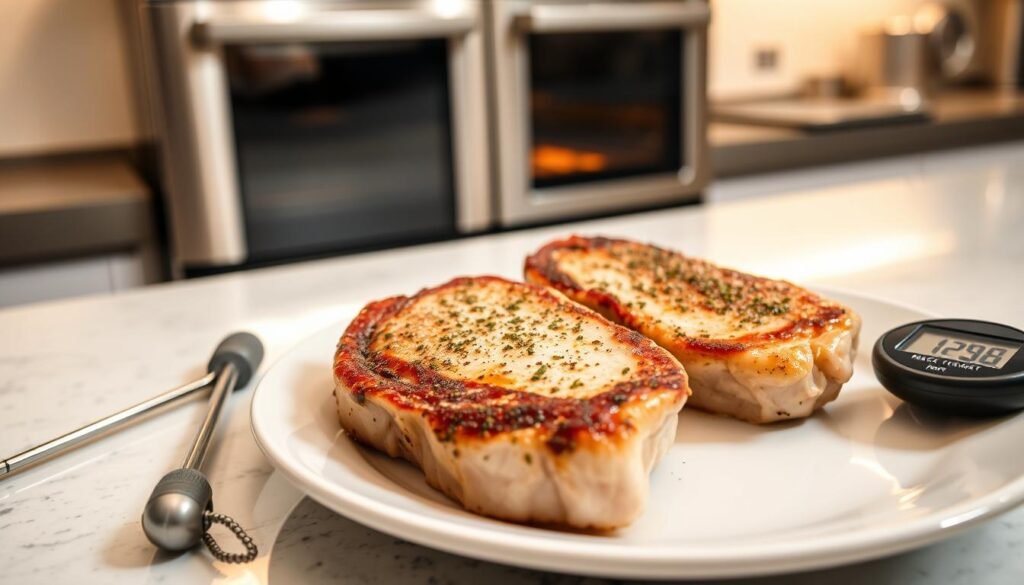
When cooking pork chops in the oven, knowing the right cooking time is key. The time needed depends on the thickness and type of pork chops. I’ll share general cooking times and what can affect them.
General Cooking Times by Thickness
Pork chops of different thicknesses need different cooking times. For example, boneless pork chops take about 7 minutes per ½ inch at 400°F. Bone-in pork chops need about 8 minutes. Here’s a quick guide:
| Thickness | Boneless Cooking Time | Bone-in Cooking Time |
|---|---|---|
| ½ inch | 7 minutes | 8 minutes |
| 1 inch | 10 minutes | 12 minutes |
| 1 ½ inches | 14 minutes | 16 minutes |
| 2 inches | 18 minutes | 20 minutes |
Factors Affecting Cooking Time
Several things can change how long it takes to cook pork chops. These include:
- Starting Temperature: Thicker cuts or chops straight from the fridge may need more time.
- Oven Type: Cooking times can differ between conventional and convection ovens.
- Elevation: Cooking times can be longer at higher altitudes.
Using a meat thermometer is crucial for perfect doneness. The internal temperature should reach 145°F for safety.
Recommended Oven Temperature for Pork Chops
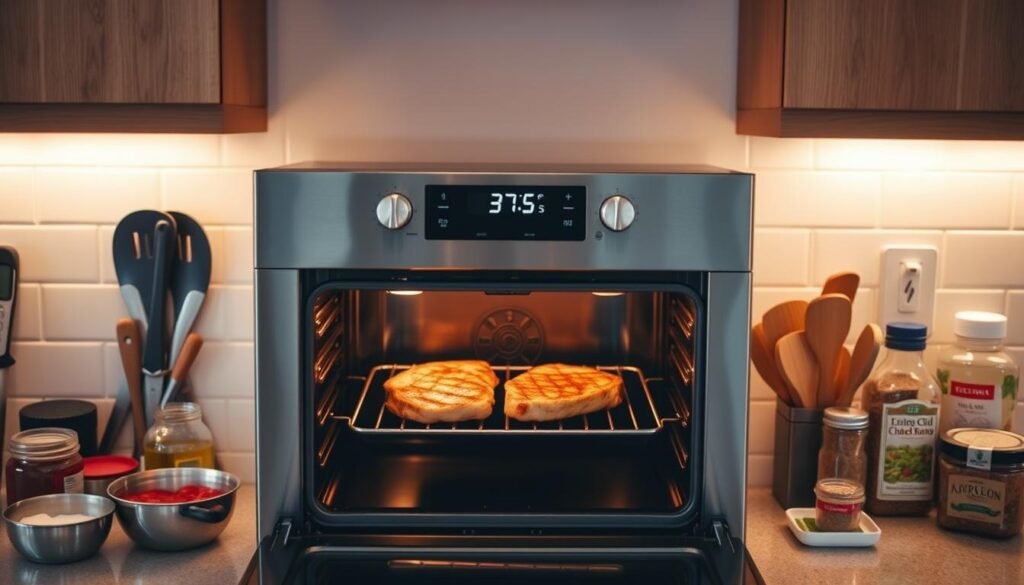
Finding the right oven temperature is key for juicy and tasty pork chops. A temperature between 400°F and 425°F works best. It helps create a nice sear and cooks the meat evenly.
This temperature also boosts the Maillard reaction. This reaction makes the pork chops look and taste better.
Best Practices for Preheating
Preheating your oven is a must for good cooking. Following some preheating tips can really help. Always let your oven get to the right temperature before adding the pork chops.
This ensures the meat cooks right away. It keeps the meat moist and flavorful. Using an oven thermometer is a good idea to check if your oven is at the right temperature.
I suggest preheating for at least 15 minutes for the best results.
Understanding Cooking Methods
There are different ways to cook pork chops, each with its own taste and texture. Baking is a favorite because it cooks evenly and doesn’t need much attention. Broiling is quicker, great for a fast dinner, and adds a nice crust.
No matter the method, keeping the oven at the right temperature is important. It makes the pork chops tender and enjoyable to eat.
Adding Flavor: Seasonings and Marinades
There are many ways to make pork chops taste better. I try out different marinades and seasonings to find the perfect mix. The right combination can make a dish truly memorable. Here are some of my go-to choices.You can learn more about how to cook asparagus.
Popular Marinades for Pork Chops
- Soy Sauce Marinade: Soy sauce, garlic, and brown sugar create a sweet and savory flavor.
- Citrus Marinade: Orange or lemon juice, olive oil, and herbs add a refreshing twist.
- Herb Marinade: Olive oil and fresh herbs like rosemary and thyme offer a fragrant taste.
Spice Blends to Try
- Pork Chop Seasoning: Paprika, onion powder, and oregano boost the meat’s natural taste.
- BBQ Rub: Brown sugar, chili powder, and cumin add a smoky sweetness.
- Italian Spice Mix: Dried basil, oregano, and garlic powder give a Mediterranean flavor.
Searing Vs. Baking: Which is Best?
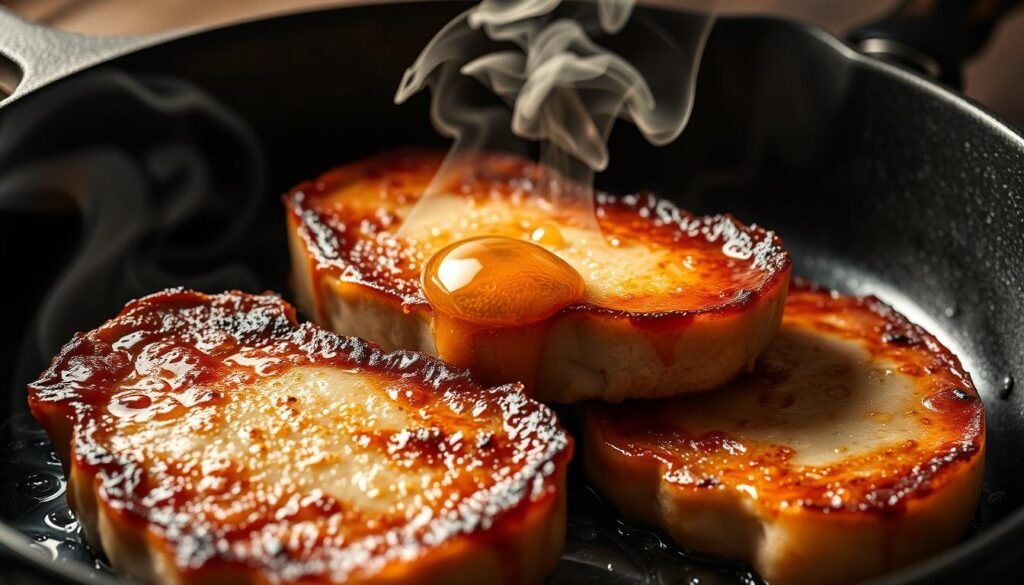
Deciding between searing and baking pork chops can be tricky. Each method has its own perks that can make your dish better. Searing creates a crispy crust and keeps the meat juicy and tasty. Baking, on the other hand, is simpler and cooks evenly without extra steps.
Benefits of Searing Before Baking
Searing pork chops adds a rich flavor and texture. The pan’s high heat makes a golden crust. This crust not only tastes great but also keeps the meat moist during baking.
When Baking Alone is Sufficient
Baking pork chops is easy and still yields tasty results. It’s perfect for busy nights or when you want the oven to do the work. Even without searing, baked pork chops can be juicy and full of flavor. Baking is best for thicker cuts, ensuring they cook evenly.
| Method | Pros | Best For |
|---|---|---|
| Searing |
|
Thin to medium cuts |
| Baking |
|
Thicker cuts or casual cooking |
Checking Doneness: When is it Ready?
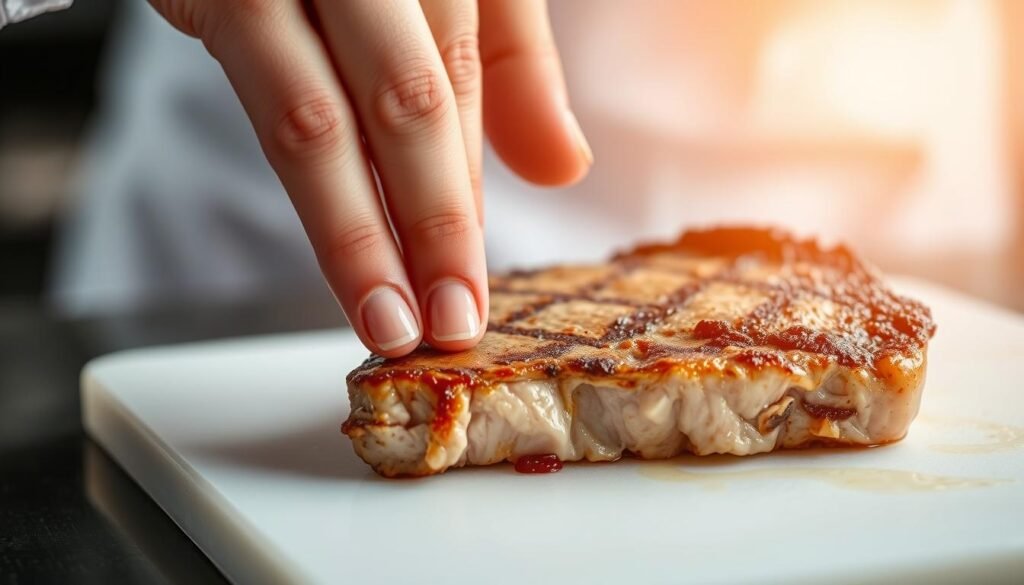
It’s important to know when pork chops are cooked just right. The best way to check is with a meat thermometer. This tool gives you the exact internal temperature, making sure it hits 145°F. Always put the thermometer in the thickest part of the chop to get accurate results.
Using a Meat Thermometer
Start checking the pork chops around the six-minute mark, if they’re thin. If they’ve been brined or were cold, check them more often. Keep checking every minute until you hit the safe temperature.
Signs of Perfectly Cooked Pork Chops
Visual signs can also tell you if they’re done. Look for a slight pink in the center and clear juices. The meat should look white, not pink. Clear juices and no redness mean they’re ready. For more tips, check out the checking doneness of pork chops guide.
Common Mistakes to Avoid
When cooking pork chops, many mistakes can ruin the dish. I’ll share tips on timing, temperature, and seasoning. These are key to making juicy pork chops, avoiding the stress of cooking.
Overcooking: How to Prevent It
One big mistake is overcooking pork chops. The right temperature is crucial. Aim for an internal temperature of about 135 degrees Fahrenheit. This ensures the meat reaches the USDA’s 145 degrees after resting.
It’s also vital to let the pork chops rest for about ten minutes. This lets the juices spread evenly, making each bite juicy. For more on avoiding overcooked pork, check out these tips on cooking pork chops.
Underseasoning: Enhancing Flavor
Another mistake is underseasoning, which makes the meat taste bland. Seasoning should be generous, with a thick layer of salt and pepper. This boosts the meat’s natural flavors, turning a simple meal into a feast.
Always taste as you go and adjust the seasoning. This way, your dishes will be more flavorful and enjoyable.
Side Dishes That Complement Pork Chops
Enjoying oven-baked pork chops gets even better with the right sides. Classic pairings bring comfort, while new combinations add excitement. Whether you like traditional or innovative sides, there’s something for everyone. Pairing pork with vegetables can make a simple dinner unforgettable.
Classic Pairings for Pork
Here are some top classic sides for pork chops:
- Mashed potatoes – Creamy and buttery, a perfect match.
- Collard greens – Slow-cooked greens add a rich flavor.
- Homemade applesauce – Sweet and pairs well with pork.
- Sweet potato hash – Sweet and warm, a great choice.
- Cauliflower mac and cheese – A gluten-free twist on a classic.
Creative Sides to Try Out
For a bold twist, try these creative sides:
- Maple-bacon Brussels sprouts – Sweet and savory, a perfect mix.
- Honey-glazed carrots and parsnips – Sweet and fresh, a delightful combo.
- Cauliflower gratin – Rich and creamy, adds elegance.
- Lemon-roasted asparagus – Bright and tangy, great with pork.
- Slice-baked potatoes – A fun twist on baked potatoes.
For more ideas, check out this link on side dishes that complement pork chops. These combinations highlight the pork and add variety to your meal. Enjoy exploring sides that match your taste.
Storing Leftover Pork Chops
After enjoying a delicious meal, I often find myself with leftover pork chops. Properly storing pork chops is essential for maintaining their flavor and texture. Sticking to a few best practices can keep those leftovers tasting just as delightful the next time I prepare them.
How to Properly Store
For effective storing pork chops, I recommend using airtight containers or wrapping them tightly in plastic wrap. This prevents air exposure which can lead to drying out. It’s best to place the cooked pork chops in the refrigerator if I plan to eat them within three to four days. For longer storage, using a freezer-safe container lets me keep them for several months without losing quality.
Reheating Tips for Maximum Flavor
When it comes to reheating pork, I aim to restore that juicy flavor. One effective method is to reheat in the oven at 350°F, placing the meat in a covered dish to retain moisture. Another option is using a skillet on medium heat, adding a splash of broth or water to prevent dryness. By following these reheating tips, I can ensure that my leftover pork chops taste just as good as when they were freshly cooked.
Creative Recipes Featuring Oven-Baked Pork Chops
Make dinner time exciting with creative pork chop recipes. Stuffed pork chops are a great choice, filled with various ingredients. This turns a simple dish into a feast. Try mixing cheeses, herbs, and veggies for a tasty twist.
One-pan meals with pork chops are also a hit. They’re easy to make and clean up. Pairing pork with roasted veggies or potatoes cooks everything at once. This saves time and adds flavor to every bite.
For more ideas and how-to guides, visit this link on recipes using pork chops. You’ll find stuffed pork chop recipes and easy one-pan meals to spice up your meals.
| Recipe Type | Key Ingredients | Cook Time |
|---|---|---|
| Stuffed Pork Chops | Cheese, Spinach, Herbs | 25-30 mins |
| One-Pan Pork Chops | Pork Chops, Baby Potatoes, Vegetables | 35-40 mins |
Give these creative pork chop recipes a try. Stuffed and one-pan meals promise to make your meals unforgettable.
Conclusion: Enjoying Your Oven-Baked Pork Chops
As I take the oven-baked pork chops out, the kitchen fills with a delicious smell. It brings back memories of family dinners full of laughter. Each bite of these tender pork chops feels like a warm hug, showing how much joy cooking can bring.
Everyone should try cooking at home and see where it takes them. You might stick to classic flavors or try something new. The best part is, you can always find inspiration, like my favorite pork chop recipe here. Making recipes your own adds a special touch to your meals.
But it’s not just about the food; it’s about the moments we share. As you cook, share your stories. Cooking is a way to show love and bring people together. It turns simple dinners into unforgettable memories.


